William Bradford (Plymouth Colony governor)
| William Bradford | |
|---|---|
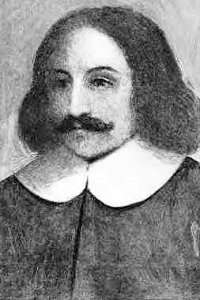 A conjectural image of Bradford, produced as a postcard in 1904 by A.S. Burbank of Plymouth.[1] | |
| 2nd, 5th, 7th, 9th & 12th Governor of Plymouth Colony | |
|
In office 1621–1657 | |
| Personal details | |
| Born |
ca. May 1590 Austerfield, West Riding of Yorkshire, England |
| Died |
May 9, 1657 (aged 67) Plymouth Colony |
| Spouse(s) |
Dorothy May[2] Alice (Carpenter) Southworth[3] |
| Children | 4 |
| Occupation | weaver, settler |
| Profession | Colonial Governor, Judge |
| Portfolio | treasurer, chief magistrate |
| Religion | Puritan |
| Signature |
|
| Website | http://www.history.com/topics/william-bradford |
William Bradford (c.1590 – May 9, 1657) was an English Separatist originally from the West Riding of Yorkshire, who later moved to Leiden in Holland, and then in 1620 migrated to the Plymouth Colony on the Mayflower. He was a signatory to the Mayflower Compact and went on to serve as Governor of the Plymouth Colony intermittently for about thirty years between 1621 and 1657. His journal Of Plimoth Plantation covered the years from 1620 to 1657 in Plymouth.[4]
English origins
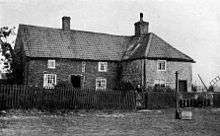
William Bradford was born to Alice and William Bradford in Austerfield, West Riding of Yorkshire, being baptized on March 19, 1589/90.[5] In a time when most of their countrymen were farmers of modest means,[6] the Bradford family owned a large farm and were considered wealthy and influential.[7]
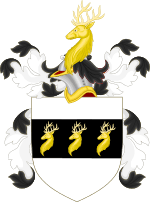
According to surgeon and historical researcher George J. Hill, Bradford's grandfather was William Bradforthe who had at least four children, including Bradford's father, and was probably of noble ancestry.[8]
Bradford's childhood was marked by numerous deaths in the family. He was just over a year old when his father died. When he was four years old, his mother remarried, and Bradford was sent to live with his grandfather.[5] Two years later, his grandfather died, and he returned to live with his mother and stepfather. A year later, in 1597, his mother died. Bradford thus became an orphan at the age of seven and was sent to live with two uncles.[5]
His uncles wanted young Bradford to help on the farm, and he later noted in his journal that he suffered at that time from a "long sickness" and was unable to work. He instead turned to reading. He became familiar with the Bible and classic works of literature. This, too, is seen by some as a key factor in his intellectual curiosity and his eventual attraction to the Separatist Church.[9]
Separatist congregation
When Bradford was twelve years old a young friend invited him to hear the Rev Richard Clyfton preach ten miles away in All Saints' Church that is located in Babworth. Clyfton was a minister who believed that the Church of England ought to institute strict reforms to eliminate all vestiges of Roman Catholic practices. Proponents believed that this would result in a purer Christian church. Bradford was inspired by Clyfton’s preachings and continued to attend his sermons, even though he was forbidden by his uncles.[10]
During one meeting, Bradford met William Brewster, who was a bailiff and postmaster.[11] His residence was at Scrooby manor, four miles from Austerfield. During frequent visits, Bradford borrowed books from Brewster, and Brewster regaled the young man with stories of the efforts toward church reform taking place across England.[11]
When King James I came to the English throne in 1603, he declared that he would put an end to church reform movements and deal harshly with radical critics of the Church of England.[12] By 1607, secret meetings were being held at Scrooby Manor and about 50 reform-minded individuals began to celebrate the Sabbath led by Richard Clyfton and the Rev John Robinson. This group decided that reform of the Church of England was hopeless and they would sever all ties, and they became known as Separatists.
The weekly meetings of the Separatists attracted the attention of the Archbishop of York, and many members of the congregation were arrested in 1607.[6] Brewster was found guilty of being "disobedient in matters of religion" and was fined. Some members were imprisoned and others were watched "night and day", according to Bradford, by those loyal to the archbishop.[6] Adding to their concerns, the Scrooby congregation learned that other Separatists in London had been imprisoned and left to starve.[13]
The Scrooby congregation decided in 1607 to leave England unlawfully for the Dutch Republic (where religious freedom was permitted), and William Bradford determined to go with them. The group encountered several major setbacks in trying to leave England, most notably their betrayal by an English sea captain who had agreed to bring the congregation to the Netherlands, but instead turned them over to the authorities.[14] Most of the congregation were imprisoned for a short time after this failed attempt, including Bradford.[15] By the summer of 1608, however, the Scrooby congregation managed to escape England in small groups, including 18-year-old William Bradford, and relocated to Leiden in the Dutch Republic.
In Leiden and London
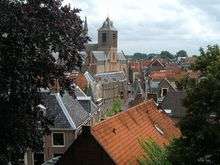
William Bradford arrived in Amsterdam in August 1608. He had no family with him and was taken in by the Brewster household. The Separatists had to work the lowest of jobs and live in poor conditions, being foreigners and having spent most of their money in attempts to get to the Dutch Republic. After nine months, the congregation chose to relocate to the smaller city of Leiden.[16]
Bradford continued to reside with the Brewster family in a poor Leiden neighborhood known as Stink Alley.[17] Conditions changed dramatically for Bradford when he turned 21 and was able to claim his family inheritance in 1611. He bought his own house, set up a workshop as a fustian weaver, and earned a reputable standing.[18]
In 1613, Bradford married Dorothy May, the daughter of a well-off English couple living in Amsterdam. The couple was married in a civil service, as the Separatists could find no example of a religious service in the Scriptures.[19] In 1617, the Bradfords had their first child John Bradford.[20]
In 1619, William Bradford sold his house in Leiden and appears in March 1620 tax records in London being taxed for personal property at the Duke’s Place, Aldgate. Aldgate was an area of London known to be the residence of numerous Dutch merchants, as well as many religious dissenters. Some familiar Mayflower names of families living in the area included Allerton, Tilley, Sampson, and Hopkins.
One family in Aldgate played an important part in Bradford's life in America. Edward and Alice (Carpenter) Southworth and their two sons were residing at Heneage House, the Duke’s Place, in Aldgate in 1620. Southworth was a highly respected leader of the Leiden group who died in 1621/22. His widow Alice then left for Plymouth Colony on the Anne in 1623 to become the wife of widower William Bradford.[21]
Voyage preparations and the Speedwell
By 1617, the Scrooby congregation began to plan the establishment of their own colony in the Americas.[22] The Separatists could practice religion as they pleased in the Dutch Republic, but they were troubled by the fact that their children were being influenced by Dutch customs and language, after nearly ten years in the Netherlands. Therefore, they commenced three years of difficult negotiations in England seeking permission to settle in the northern parts of the Colony of Virginia (which then extended north to the Hudson River).[23] The colonists also struggled to negotiate terms with a group of financial backers in London known as the Merchant Adventurers. By July 1620, Robert Cushman and John Carver had made the necessary arrangements, and approximately fifty Separatists departed Delftshaven on board the Speedwell.[24]
It was an emotional departure. Many families were split, as some Separatists stayed behind in the Netherlands, planning to make the voyage to the New World after the colony had been established. William and Dorothy Bradford left their three-year-old son John with Dorothy's parents in Amsterdam, possibly because he was too frail to make the voyage.[24]
According to the arrangements made by Carver and Cushman, the Speedwell was to meet with the Mayflower off the coast of England and both were destined for the northern part of the Colony of Virginia. The Speedwell, however, proved to be not structurally sound enough to make the voyage, and some of the passengers were transferred aboard the Mayflower, making crowded conditions. Joining the Scrooby congregation were about 50 colonists who had been recruited by the Merchant Adventurers for their vocational skills, which would prove useful in establishing a colony.[25] These passengers of the Mayflower, both Separatist and non-Separatist, are commonly referred to today as "Pilgrims." The term is derived from a passage in Bradford's journal, written years later, describing their departure from the Netherlands (itself an allusion to Hebrews 11:13 in the Bible):
...With mutual embraces and many tears, they took their leaves of one another, which proved to be the last leave to many of them...but they knew they were pilgrims and looked not much on those things, but lifted their eyes to heaven, their dearest country and quieted their spirits...[26]
The Mayflower voyage

The Mayflower departed Plymouth, England on September 6/16, 1620. The 100-foot ship had 102 passengers and a crew of 30-40 in extremely cramped conditions. By the second month out, the ship was being buffeted by westerly gales, causing the ship‘s timbers to be badly shaken, with caulking failing to keep out sea water, and with passengers lying wet and ill, even in their berths. There were two deaths on the trip, a crew member and a passenger. (The worst was yet to come after arriving at their destination. In the space of several months, almost half the passengers perished in a cold, harsh, unfamiliar New England winter.[27])
They spotted Cape Cod hook on November 9/19, 1620, after about a month of delays in England and 2 months at sea. They spent several days trying to get south to their planned destination of the Colony of Virginia, but strong winter seas forced them to return to the harbor at Cape Cod hook, now called Provincetown Harbor, where they anchored on November 11/21, 1620. The Mayflower Compact was signed that day, Bradford being one of the first to sign.[27][28]
Anchored and first explorations at Plymouth Colony
Up to this time, Bradford, age 30, had yet to assume any significant leadership role in the colony. The Mayflower anchored in present-day Provincetown Harbor and, when the time came to search for a place for settlement, Bradford volunteered to be a member of the exploration parties.[29] In November and December, these parties made three separate ventures from the Mayflower on foot and by boat, finally locating what is now Plymouth Harbor in mid-December and selecting that site for settlement.
During the first expedition on foot, Bradford got caught in a deer trap made by Native Americans and hauled nearly upside down.[30] The third exploration departed from the Mayflower on December 6, 1620, when a group of men (including Bradford) located present-day Plymouth Bay. A winter storm nearly sank their boat as they approached the bay, but the explorers managed to successfully land on Clark's Island, suffering from severe exposure to the cold and waves.[31]
During the ensuing days, they explored the bay and found a suitable place for settlement, now the site of downtown Plymouth, Massachusetts. The location featured a prominent hill (now known as Burial Hill) ideal for a defensive fort. There were numerous brooks providing fresh water. Also, the site had been the location of a Native American village known as Patuxet; therefore, much of the area had already been cleared for planting crops. The Patuxet tribe had been wiped out by plagues between 1616 and 1619 resulting from contact with English fishermen—diseases to which the Patuxet had no immunity.[32] Bradford later wrote that bones of the dead were clearly evident in many places.[33]
Loss of first wife
When the exploring party made their way back on board, he learned of the death of his wife Dorothy. Dorothy (May) Bradford from Wisbech, Cambridgeshire fell overboard off the deck of the Mayflower during his absence and drowned. William Bradford recorded her death in his journal.[34]
Great sickness
The Mayflower arrived in Plymouth Bay on December 20, 1620. The settlers began building the colony's first house on December 25 (Christmas). Their efforts were slowed, however, when a widespread sickness struck the settlers. The sickness had begun on the ship.[35] On January 11, 1621, Bradford was helping to build houses when he was suddenly struck with great pain in his hipbone and collapsed. He was taken to the "common house" (the only finished house built then) and it was feared that he would not last the night.[36]
Bradford recovered, but many of the other settlers were not so fortunate. During the months of February and March 1621, sometimes two or three people died a day. By the end of the winter, half of the 100 settlers had died.[37] In an attempt to hide their weakness from Native Americans who might be watching them, the settlers buried their dead in unmarked graves on Cole's Hill, often at night, and made efforts to conceal the burials.[38]
During the epidemic, there were only a small number of men who remained healthy and bore the responsibility of caring for the sick. One of these was Captain Myles Standish, a soldier who had been hired by the settlers to coordinate the defense of the colony. Standish cared for Bradford during his illness and this was the beginning of a bond of friendship between the two men.[39] Bradford was elected governor soon after Carver's death and, in that capacity, he worked closely with Standish. Bradford had no military experience and therefore came to rely on and trust the advice of Captain Myles Standish concerning military matters.[40]
Early service as governor
| Governors of Plymouth Colony[41] | ||
|---|---|---|
| Dates | Governor | |
| 1620 | John Carver | |
| 1621–1632 | William Bradford | |
| 1633 | Edward Winslow | |
| 1634 | Thomas Prence | |
| 1635 | William Bradford | |
| 1636 | Edward Winslow | |
| 1637 | William Bradford | |
| 1638 | Thomas Prence | |
| 1639–1643 | William Bradford | |
| 1644 | Edward Winslow | |
| 1645–1656 | William Bradford | |
| 1657–1672 | Thomas Prence | |
| 1673–1679 | Josiah Winslow | |
| 1680–1692 | Thomas Hinckley | |
On March 16, the settlers had their first meeting with the Native Americans who lived in the region when Samoset walked into the village of Plymouth as a representative of Massasoit, the sachem of the Pokanoket. This soon led to a visit by Massasoit himself on March 22, during which the leader of the Pokanoket signed a treaty with John Carver, Governor of Plymouth. The treaty declared an alliance between the Pokanoket and Plymouth and required the two parties to aid each other militarily in times of need.[42]
Bradford recorded the language of the brief treaty in his journal. He soon became governor and the clause of the treaty that occupied much of his attention as governor pertained to mutual aid. It read, "If any did unjustly war against [Massasoit], we would aid him; if any did war against us, Massasoit should aid us."[43] This agreement secured for the English a desperately needed ally in New England, though it resulted in tensions between the English and Massasoit's rivals, such as the Narragansetts and the Massachusetts.[40] In April 1621, Governor Carver collapsed while working in the fields on a hot day. He died a few days later. The settlers of Plymouth then chose Bradford as the new governor, a position which he retained for most of the rest of his life.[44]
The elected leadership of Plymouth Colony at first consisted of a governor and an assistant governor. The assistant governor for the first three years of the colony's history was Isaac Allerton. In 1624, the structure was changed to a governor and five assistants who were referred to as the "court of assistants," "magistrates," or the "governor's council." These men advised the governor and had the right to vote on important matters of governance, helping Bradford in guiding the growth of the colony and its improvised government.[45][46] Assistants during the early years of the colony included Thomas Prence, Stephen Hopkins, John Alden, and John Howland.[47]
Literary works
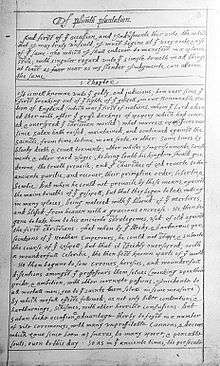
William Bradford's most well-known work by far is Of Plymouth Plantation. It is a detailed history in journal form about the founding of the Plymouth Colony and the lives of the colonists from 1621 to 1646.[48] Bradford's journal is described as a retrospective account of his recollections and observations. The first work was written in 1630; the second was never finished, but "between 1646 and 1650, he brought the account of the colony's struggles and achievements through the year 1646."[49] As Walter P. Wenska states, "Bradford writes most of his history out of his nostalgia, long after the decline of Pilgrim fervor and commitment had become apparent. Both the early annals which express his confidence in the Pilgrim mission and the later annals, some of which reveal his dismay and disappointment, were written at about the same time."[48] In Of Plymouth Plantation, Bradford drew deep parallels between everyday life and the events of the Bible. As Philip Gould writes, "Bradford hoped to demonstrate the workings of divine providence for the edification of future generations."[49]
In 1888, Charles F. Richardson referred to Bradford as a "forerunner of literature" and "a story-teller of considerable power." Moses Coit Tyler called him "the father of American history."[50] Many American authors have cited his work in their writings; for example, Cotton Mather referred to it in Magnalia Christi Americana and Thomas Prince referred to it in A Chronological History of New-England in the Form of Annals. Even today it is considered a valuable piece of American literature, included in anthologies and studied in literature and history classes. It has been called an American classic and the pre-eminent work of art in seventeenth-century New England."[50]
The Of Plymouth Plantation manuscript disappeared by 1780,[51] "presumably stolen by a British soldier during the British occupation of Boston"; it reappeared in Fulham, England.[49] Philip Gould states, "In 1855, scholars intrigued by references to Bradford in two books on the history of the Episcopal Church in America (both located in England) located the manuscript in the bishop of London's library at Lambeth Palace."[49] A long debate ensued as to the rightful home for the manuscript. Multiple attempts by United States Senator George Frisbie Hoar and others to have it returned proved futile at first. According to Francis B. Dedmond, "after a stay of well over a century at Fulham and years of effort to [e]ffect its release, the manuscript was returned to Massachusetts" on May 26, 1897.[52]
Bradford's journal was also published, even though it did not become Of Plymouth Plantation. It was contributed to another work entitled Mourt's Relation which was written in part by Edward Winslow and published in England in 1622 by one of Bradford's contemporaries. It was intended to inform Europeans about the conditions surrounding the American colonists at the Plymouth Colony. As governor of the Plymouth Colony, his work was considered a valuable contribution and was thus included in the book. It is not typically referred to as one of Bradford's significant works due to the fact that it was published under someone else's name, despite the fact that the book included a large amount of Bradford's work.
Bradford's Dialogues are a collection of fictional conversations between the old and new generations. In the Dialogues, conversations ensue between "younge men" and "Ancient men," the former being the young colonists of Plymouth, the latter being "the protagonists from Of Plymouth Plantation" (Sargent 413).[53] As Mark L. Sargent states: "By bringing the young from Plymouth Plantation and the ancients from Of Plymouth Plantation into 'dialogue,'...Bradford wisely dramatizes the act of historical recovery as a negotiation between the two generations, between his young readers and his text."[53] Today, only a small portion remains of the Dialogues; however, a modified exists copy made by Nathaniel Morton.
Family
William Bradford married:
- Dorothy May in Amsterdam, Holland on December 10, 1613. Their marriage record indicates that she was 16 years old and was from Wisbech in Cambridgeshire. The record also notes a Henry May, who may have been her father. William and Dorothy had one son.
- Her death and memorial: On December 17, 1620, Dorothy fell from the deck of the Mayflower into the icy waters of Cape Cod Harbor, where the ship was anchored, and drowned. Her husband was with others on an expedition ashore and only learned of her death on his return to the Mayflower.
- She was one of four Mayflower passengers who died between December 4/14 and 8/18, 1620, including Edward Thomson, Jasper More (age 7 years), and James Chilton. William Butten was the first to die in Provincetown Harbor, dying on November 16. They are all commemorated on two cenotaphs in Provincetown, one at Winthrop Street Cemetery and one at the Mayflower Passengers Who Died At Sea Memorial. Their burial places ashore are unknown and may have been unmarked in those very early days after the Mayflower landing.
- The death of these five persons was just a precursor of the deaths to come, consuming about half the Mayflower company in that first bitter winter of 1620-1621.[54]
- Alice (Carpenter) Southworth, age about 32, in Plymouth on August 14, 1623. She had arrived on the ship Anne some weeks earlier. Alice was the widow of Edward Southworth. She was one of five daughters of Alexander and Priscilla Carpenter of Wrington, co. Somerset in England, all being of Leiden about 1600. Alice brought two sons to the marriage: Constant, born about 1612, and Thomas, born about 1617. Alice and William had three children. She died in Plymouth on March 26, 1670 and was buried on Burial Hill in Plymouth near her husband's stone.[55][56][57][58]
Child of William and Dorothy Bradford:
- John was born in Leiden, Holland, about 1617. He married Martha Bourne by 1650 but had no known children. He died in Norwich, Connecticut some time before September 21, 1676.
Children of William and Alice Bradford:
- William was born on June 17, 1624 in Plymouth and died there on February 20, 1703/4. He was buried on Burial Hill in Plymouth.
- William married:
- 1. Alice Richard after April 23, 1650 and had ten children. She died in Plymouth on December 12, 1671.
- 2. Sarah (____) Griswold about 1674 and had one son.
- 3. Mary (Atwood) Holmes about 1676 and had four children.
- Mercy was born before May 22, 1627 and may have been dead before her father's 1657 will, as she was not mentioned. She married Benjamin Vermayes on December 21, 1648 in Plymouth but had no known children.[59]
- Joseph was born about 1630. He married Jael Hobart on May 25, 1664 in Hingham and had three children. He died in Plymouth on July 10, 1715.[59]
Will, death, and burial
William Bradford died on May 9, 1657 and was buried on Burial Hill in Plymouth where a large stone monument exists in memory of his life. The estate inventory for William Bradford was taken on May 22, 1657.[59][60]
See also
Notes
- ↑ Addison, 101.
- ↑ pg. 209 The Great Migration Begins: Immigrants to New England, 1620-1633
- ↑ pg. 208 The Great Migration Begins: Immigrants to New England, 1620-1633
- ↑ The fast and thanksgiving days of New England by William Deloss Love, Houghton, Mifflin and Co., Cambridge, 1895.
- 1 2 3 Schmidt, 6.
- 1 2 3 Schmidt, 17.
- ↑ Schmidt, 4.
- ↑ Mayflower Quarterly, v. 79, No. 4, pp. 328-341
- ↑ Schmidt, 7.
- ↑ Schmidt, 8
- 1 2 Schmidt, 9.
- ↑ Schmidt, 12.
- ↑ Goodwin, 12.
- ↑ Schmidt, 21.
- ↑ Goodwin, 27.
- ↑ Schmidt, 33
- ↑ Schmidt, 35.
- ↑ Philbrick, 17.
- ↑ Schmidt, 37
- ↑ Goodwin, 38.
- ↑ Mayflower Quarterly, vol. 79, no. 4 December 2013, p. 333
- ↑ Schmidt, 40.
- ↑ Philbrick, 19
- 1 2 Philbrick, 23.
- ↑ Philbrick, 25.
- ↑ Bradford quoted in Schmidt, 51.
- 1 2 Eugene Aubrey Stratton, Plymouth Colony: Its History and People, 1620-1691, (Salt Lake City: Ancestry Publishing, 666), p. 413
- ↑ George Ernest Bowman, The Mayflower Compact and its signers, (Boston: Massachusetts Society of Mayflower Descendants, 1920). Photocopies of the 1622, 1646, and 1669 versions of the document pp. 7-19.
- ↑ Schmidt, 80.
- ↑ Schmidt, 69.
- ↑ Philbrick, 70-73.
- ↑ Philbrick, 79.
- ↑ Philbrick, 80.
- ↑ Doherty, 73.
- ↑ Goodwin, 114.
- ↑ Philbrick, 85.
- ↑ Schmidt, 88.
- ↑ Philbrick, 90.
- ↑ Haxtun, 17
- 1 2 Philbrick, 114.
- ↑ "Governors of Plymouth Colony". Pilgrim Hall Museum. 1998. Archived from the original on February 15, 2007. Retrieved 2007-04-02.
- ↑ Philbrick, 99.
- ↑ Goodwin, 125.
- ↑ Schmidt, 97.
- ↑ Goodwin, 159.
- ↑ Stratton, 145.
- ↑ Stratton, 151, 156, 281, 311
- 1 2 Wenska, 152
- 1 2 3 4 Gould, 349
- 1 2 Wenska, 151.
- ↑ Morison, Samuel Eliot (1952). Of Plymouth Plantation, 1620-1647. Knopf. pp. xxx. ISBN 978-0394438955.
- ↑ Dedmond, Francis B (1985). "A Forgotten Attempt to Rescue the Bradford Manuscript". The New England Quarterly. Boston: Colonial Society of Massachusetts and Northeastern University. 58 (2): 242–252. doi:10.2307/365515. ISSN 0028-4866.
- 1 2 Sargent, 413.
- ↑ "Dorothy May Bradford (1597 - 1620) - Find A Grave Memorial".
- ↑ "Alice Carpenter Bradford (1590 - 1670) - Find A Grave Memorial".
- ↑ Mayflower Quarterly, v. 79, no. 4, pp. 328, 334
- ↑ Charles Edward Banks, The English Ancestry and Homes of the Pilgrim Fathers: who came to Plymouth on the Mayflower in 1620, the Fortune in 1621, and the Anne and the Little James in 1623 (Baltimore, MD.:Genealogical Publishing Co., 2006) p. 117
- ↑ Eugene Aubrey Stratton. Plymouth Colony: Its History and People, 1620–1691, (Ancestry Publishing, Salt Lake City, UT, 1986) p. 258
- 1 2 3 A genealogical profile of William Bradford, (A collaboration between Plymouth Plantation and New England Historical Genealogical Society) Archived November 2, 2011, at the Wayback Machine.
- ↑ "William Bradford (1590 - 1657) - Find A Grave Memorial".
References
- Abrams, Ann Uhry (1999). The Pilgrims and Pocahontas: Rival Myths of American Origin. Boulder: Westview Press. ISBN 0-8133-3497-7.
- Addison, Albert Christopher (1911). The Romantic Story of the Mayflower Pilgrims. Boston: L.C. Page & Company. OCLC 1356038.
- Doherty, Kieran (1999). William Bradford: Rock of Plymouth. Brookfield, Connecticut: Twenty-First Century Books. ISBN 0-585-21305-4.
- Goodwin, John A. (1920) [1879]. The Pilgrim Republic: An Historical Review of the Colony of New Plymouth. Boston: Houghton Mifflin Co. OCLC 316126717.
- Gould, Philip (2009). "William Bradford 1590-1657". In Lauter, Paul. The Heath Anthology of American Literature: Beginnings to 1800. A. Boston: Houghton Mifflin. pp. 348–350. ISBN 0-618-89799-2.
- Haxtun, Annie A. (1899). Signers of the Mayflower Compact. Baltimore: The Mail and Express. OCLC 2812063.
- Philbrick, Nathaniel (2006). Mayflower: A Story of Community, Courage and War. New York: Penguin Books. ISBN 978-0-14-311197-9.
- Sargent, Mark L. (1992). "William Bradford's 'Dialogue' with History". The New England Quarterly. Boston: Colonial Society of Massachusetts and Northeastern University. 65 (3): 389–421. doi:10.2307/366325. ISSN 0028-4866.
- Schmidt, Gary D. (1999). William Bradford: Plymouth's Faithful Pilgrim. Grand Rapids: William B. Eerdmans Publishing Co. ISBN 978-0-8028-5148-2.
- Stratton, Eugene A. (1986). Plymouth Colony: Its History & People, 1620–1691. Salt Lake City: Ancestry Incorporated. ISBN 0-916489-13-2.
- Wenska, Walter P (Fall 1978). "Bradford's Two Histories: Pattern and Paradigm in 'Of Plymouth Plantation'". Early American Literature. Chapel Hill: University of North Carolina Press. 13 (2): 151–164. ISSN 0012-8163.
Further reading
- William Bradford correspondence, 1638–1648 (2 items) are held in the Library of Congress.
External links
| Wikimedia Commons has media related to William Bradford (Plymouth Colony governor). |
| Wikiquote has quotations related to: William Bradford (1590-1657) |
| Wikisource has the text of a 1911 Encyclopædia Britannica article about William Bradford (governor). |
- Works by William Bradford at Project Gutenberg
- Works by or about William Bradford at Internet Archive
- Works by William Bradford at LibriVox (public domain audiobooks)

- Bradford's History at the Pilgrim Hall Museum
- Full Text Bradford's book Of Plymouth Plantation (provided by Internet Archive)
- "Writings of William Bradford" from C-SPAN's American Writers: A Journey Through History
- William Bradford at Find a Grave